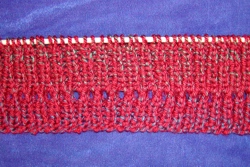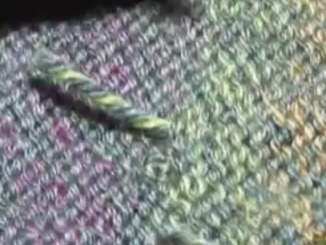
If you are new to knitting, putting these abbreviations into practice can be difficult. In this article, we will add some examples of those abbreviations with quick projects you can do on your own, to practice following a pattern. Or, you can choose to watch the video tutorial at the bottom of this page and follow along visually.
Knitting Eyelets into a Project
The following pattern example includes eyelets knitted into a piece of rib knit. The pattern reads:
- Cast on 64 st
- 1st row: k2, *p1, k1. Repeat from * to the end of the row.
- Rows 2 – 5: Repeat 1st row 4 more times.
- Row 6: k2, *wl. fwd., k2tog. Repeat from * to the end of the row.
- Rows 7 – 16: Repeat 1st row 9 times
The Translated Knitting Pattern
First, you will need to decipher the pattern. Most patterns come with a glossary of the knitting abbreviations used in the pattern, but we have a list here as well. The above pattern then reads:
- Cast on 64 st
- 1st row: Knit 2, *Purl 1, Knit 1. Repeat from * to the end of the row. (So, you will purl 1, knit 1, purl 1, knit 1 and on and on until the row ends.)
- Rows 2 – 5: Repeat 1st row 4 more times. (So, on Row 2, you will knit 2, then purl 1, knit 1, purl 1, and so on, repeating the process through the 5th row.)
- Row 6: Knit 2, *Wool Forward (also known as a Yarn Over), Knit 2 Together. Repeat from * to the end of the row. (So, you will knit 2, wool forward/yarn over, knit 2 together, wool forward/yarn over, knit 2 together, etc.)
- Rows 7 – 16: You’ll repeat what you did on the 1st row through the 16th row.



